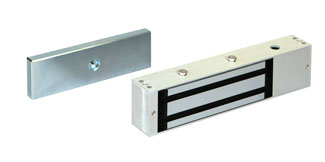When choosing electrified locking devices for your facility, it’s essential to understand the difference between fail-safe and fail-secure options. These terms determine how a lock behaves during a power outage and play a critical role in access control and safety compliance.
Fail-Safe Locks: Unlocked Without Power

A fail-safe locking device unlocks when power is lost. It requires power to remain locked, ensuring that in the event of a power outage, occupants can exit or access specific areas as needed.
Common Uses
- Fire-Rated Stairwell Doors: Allows people in stairwells to seek refuge on certain floors and enables first responders to access necessary areas during emergencies.
- Access-Controlled Interior Doors: In some jurisdictions, fail-safe locks are required to prioritize safety and accessibility.
Key Consideration
While fail-safe locks enhance safety during emergencies, they may compromise security by leaving doors unlocked during power outages.
Fail-Secure Locks: Locked Without Power

A fail-secure locking device remains locked when power is lost. It requires power to unlock, making it ideal for maintaining security during power outages.
Common Uses
- Main and Employee Entrances: Ensures unauthorized individuals cannot enter the building without a key or access credential.
- Perimeter Doors: Maintains security for exterior access points.
Key Consideration
While fail-secure locks provide better security, they require careful planning to ensure compliance with emergency exit requirements.
Choosing the Right Locking Device
Building Codes and Safety Regulations
- Building codes require that occupants can always exit freely during emergencies, even if the doors are locked. This is why exit devices and fail-safe trims are commonly used on emergency exits.
- Ensure you consult local regulations to determine whether fail-safe or fail-secure devices are required for specific doors.
Power Consumption
- Fail-Safe Devices: Require continuous power to stay locked, increasing energy consumption and operating costs.
- Fail-Secure Devices: Use power only during unlocking, making them more energy-efficient.
Security Needs
- Use fail-secure locks for perimeter doors to prevent unauthorized access during power outages.
- Consider fail-safe locks for doors that prioritize life safety, such as stairwells or emergency exits.
Specialized Solutions
Certain hardware products, like electric latch retraction exit devices, offer a hybrid approach:
- Fail-Secure During Power Outages: These devices lock securely when power is lost.
- Latch Retraction: Allows doors to operate easily during normal business hours.
- Energy Efficiency: They consume power briefly during activation, minimizing energy costs.
Detex Products
| Product | Fail-Safe or Fail-Secure? | During loss of power, product is… |
|---|---|---|
| Electric Strike | Fail-Safe (Field Selectable) | Unlocked |
| Electric Strike | Fail-Secure (Field Selectable) | Locked |
| Electromagnetic Lock | Fail-Safe | Unlocked |
| Electric Lever Trim | Fail-Safe (Field Selectable) | Unlocked |
| Electric Lever Trim | Fail-Secure (Field Selectable) | Locked |
| Electric Latch Retraction (ER EX) | Always Fail-Secure | Locked |
| Electric Dogging (ED) | Always Fail-Secure | Locked |
Final Thoughts
Selecting the right locking device involves balancing security, safety, and operational efficiency. Fail-safe and fail-secure devices serve different purposes, so it’s essential to evaluate your facility’s needs and regulatory requirements before making a decision.
By understanding these options, you can ensure your building is both secure and compliant, no matter the situation.






